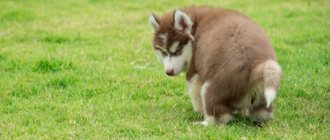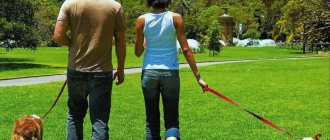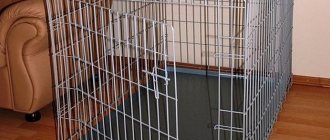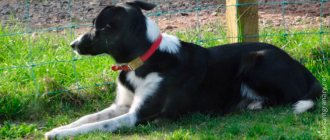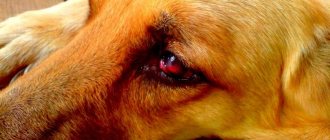Thanks to its thick coat, the Caucasian Shepherd feels comfortable when kept in the yard.
This dog can be on the street all year round and is often purchased as a guard for a country house - the Caucasian Shepherd has the character of a real security guard and watchman.
But the frost resistance of this breed does not mean at all that the Caucasian Shepherd can do without shelter from bad weather or, conversely, the scorching sun.
Keeping such a large pet in the house is very difficult.
That is why the owner should take time to build a dog house. This is also important because even the life expectancy of the pet may depend on the choice of place of keeping.
What is better - a booth or an aviary?
The booth allows the Caucasian Shepherd to shelter from bad weather, but does not restrict the dog’s free movement around the yard, and if the fence is not strong enough, it will not be able to prevent its escape.
An enclosure, even an indoor one, is not able to completely protect a pet from cold or heat..
The best choice would be not an aviary or a booth separately, but an aviary with a booth and a walk.
Ideas and unusual options for dog houses (photos)
Dog owners often show their design skills not only when building their own homes, but also when building a house for their beloved pet.
- So, you can find a booth turned into a flower bed. Dogs, as a rule, are not against these options:
- Many dog owners use scrap materials when building a kennel for their beloved pet. For example, a wooden barrel lying around in the basement:
- Contemporary art lovers are building “mansions” for dogs with panoramic windows and designer kennel models:
- And, of course, fairytale castles and wooden huts:
- And a few more original models that owners lovingly build for their four-legged friends, so that they feel cozy, comfortable and fun.
Pros and cons of the booth
pros:
- Protects the dog from adverse weather conditions.
- Creates a feeling of confidence in the pet.
- If there is a chain, it allows you to temporarily isolate the shepherd if necessary.
- It can serve as a kind of decoration for a courtyard.
Minuses:
- Inability to isolate the dog for a long time.
- Not the most convenient solution for the owner of a breeding bitch, since the puppies will crawl around the yard.
- Needs periodic cleaning and repair.
Project selection
Even if the animal moves freely around the yard, it is necessary to allocate a territory that the Caucasian will consider his own, where he can also be isolated if necessary. The most common options are covered enclosures covered with mesh or lattice, providing a good overview, protected from rain and sun.
When choosing a place to build in the courtyard of a private house, you should take into account the need of the Caucasian to observe and control what is happening. Therefore, it is best to place the building where the approach to the gates and doors of the house will be clearly visible. If possible, it is better to use an elevation - this way you can provide visibility and also reduce the risk of flooding the enclosure during rains or melting snow. You definitely need to make a booth inside where the dog will sleep and also hide in the heat or bad weather.
IMPORTANT: It is better to place an enclosure with a booth near other buildings; their walls will provide reliable protection from wind and drafts. But it is better to avoid proximity to the fence - the dog will be constantly worried about passers-by.
How to choose the right place
It should be located somewhat away from residential buildings, but so that the dog, while there, can monitor what is happening in the yard. It is necessary that the Caucasian Shepherd dog from the booth can see the gate or entrance to the yard, as well as the door of the house.
IMPORTANT!
The place for the kennel should not be located in a low area, since during rain water will flow there from the slopes.
The best place for a kennel is on a hill, away from an outdoor toilet, pigsty, barn, poultry house or other outbuildings that emit too strong odors that irritate the dog and disturb him.
In addition, the booth should be located so that trees, a house or a barn cover it from the wind.
How to insulate a dog house for the winter
How to keep your dog warm in cold weather and cool in hot weather. It is necessary to insulate the walls and top of the booth.
Insulation of the walls of the booth: foam inside, plank lining outside
Thermal insulation can be installed on an old kennel and added when building a new one. The project of remodeling an existing pet house does not even require drawing up a project.
- Stuff horizontal slats at a distance of 5 cm from each corner.
- Finish the edge of the hole with the same slats.
- Fill the space between the beams with mineral wool. You need to cut it 3 - 5 mm more so that it fits tightly and shrinks.
- Cover the back wall with plywood, clapboard or plastic. The sheathing should be equal in size to the width of the booth with insulation.
- Fill the corners with mineral wool.
- Screw the outer side walls to the slats with self-tapping screws.
- Seal the corners and the entire space around the hole with insulation.
- Cut out the cladding material for the booth façade, taking into account the size and shape of the opening.
- Fill all remaining fragments with insulation. Attach the front wall.
To prevent moisture from accumulating in the booth, a layer of waterproofing should be laid between the insulation and the outer wall. If there is no roofing material, you can use plastic film.
You can immediately build a booth with insulation using a similar technology, or slightly change the procedure. First, install the interior and exterior walls and install waterproofing. Fill the resulting space with heat insulator. In this option, you can use polyurethane foam.
In the northern regions, a heated booth is in demand. To do this, a niche is prepared in advance for a heating element or spiral in the side or rear wall of the dog house. The grille is located in the same plane with the wall. The dog should not touch the heating element and wires.
Kennel requirements
The kennel should be warm, cozy and protect the dog from adverse weather conditions.
It is undesirable to install either a kennel that is too small or too large . In the first, the pet will be too cramped, he will not be able to lie there, stretching out to his full length.
A kennel that is too spacious will not be a reliable shelter from the cold, since it is heated only by the heat transfer of the animal itself, and in this case, the heat will be irrationally distributed over a larger area.
The booth must be made of moisture-resistant and fire-resistant materials . If it is made, for example, from wood, then the material must be impregnated with special impregnations.
The bottom of the booth needs to be raised at least 15 cm: this will help better protect the dog from the cold.
The materials from which the dog kennel is built must be hypoallergenic and safe for animals.
Is there anything needed inside the booth?
Excessive care for a kennel-trained pet often has the opposite effect. Rags and bedding placed in the kennel to keep the dog warm become just such a disservice. They harbor fleas and other parasites that annoy the dog. If the booth is made as we outlined above, there is no need to put anything there. In cold winter, as an exception, you can cover the floor with straw, but not all dogs need this. It is better to take care of your pet in a different way. For example, think about the location of the kennel in advance so as not to place its entrance to the north, or make a wooden floor in front of the kennel so that the dog drags less dirt inside its home.
Measuring your pet to determine size
The owner of an adult Caucasian Shepherd can build a kennel for his pet according to individual sizes. Such a booth will be more comfortable for a dog than a standard one, designed for representatives of a given breed of average height and weight.
What measurements will need to be taken before starting to draw up the drawing?:
- Booth length . Equal to the length of the dog from the tip of the nose to the base of the tail +15 cm so that the animal feels comfortable and can stretch out to its full length.
- Width and height of the booth . Equal to the total height of the dog (from the top of the head to the ground) +15 cm.
- Manhole height . Subtract 10 cm from the height at the withers.
- Manhole width . The distance between the shoulder-scapular joints of the Caucasian Shepherd is measured, after which 10 cm must be added to the obtained value.
The hole should not be made too high or wide, as this helps to quickly cool the air inside the kennel.
Choosing dog house sizes
The first step is to decide on the size of the dog house. To do this, we decide what size dog you have. There are 3 types of dogs: small, medium and large. Accordingly, dachshunds and similar dogs are classified as small, German shepherds as medium-sized, and Caucasian shepherds as large. Based on this classification, it is customary to make booths of the following sizes:
- For small dogs: 700*550*600 mm (where length is first and height is last)
- For medium dogs: 1200*750*800 mm
- For large dogs: 1400*1000*950 mm
The dimensions of the doghouse can be adjusted based on the dimensions of your own dog.
In order to correctly determine the size of the booth, you must adhere to this technique:
- In order to choose the correct width of the hole, measure the width of the dog’s chest and add 5-8 cm to this value.
- The ideal height of the manhole is 5 cm below the height of the dog’s withers.
- The height of the booth should be the height of the dog at the withers + 5-8 cm.
- The depth of the kennel is equal to its height (with the exception of some dog breeds that dictate their own kennel dimensions)
As mentioned earlier, the dimensions of the booth can be “moved” a little, but only to a larger value, especially if the booth is being built for a puppy.
During the construction of the booth, you need to be aware of the following points:
- The dog’s housing should be comfortable so that it can lie down, turn around or stand up.
- The inlet opening should not be narrow; on the contrary, it is better to slightly widen it for convenience
- The kennel must be lined with insulation so that the dog does not freeze in the winter.
- Walls and roof must provide reliable protection from wind and precipitation
- The material used to make the booth must be environmentally friendly so that the dog does not spoil its health while living in the booth (it is best to use wood)
- The booth must be correctly located on the backyard territory (the side should not be windy, and the dog must see everything that is happening on the territory)
- The roof can be either single-pitched or double-pitched, there is no big difference
- For convenience, make a small attic under the roof of the booth in which you can put toys for the dog, dishes and other accessories
- The hole must be built in the direction of the long wall so that the dog can more conveniently climb into the booth
We advise you to study - Foam concrete and aerated concrete: characteristics and comparison of materials
After we have decided on the dimensions of the booth, we move on to sketching a drawing, with the help of which it is easier to build a booth with our own hands.
Medium sizes
Often a kennel is built for a puppy or young dog that is still growing and gaining weight and muscle mass. In this case, it is better to build the booth not according to individual sizes, but according to universal standards.
The average size of a booth for a Caucasian Shepherd is:
- Length: 135-140 cm.
- Height: 95-105 cm.
- Width: 95-100 cm
- Manhole size: 45-65
- Tambour length (added to the total length of the kennel): 25-35 cm.
Everything is clear with the sizes. What about the design itself?
Here, pet owners should control themselves and be guided solely by pragmatism. Beauty and originality are not what a dog needs.
In terms of design, it is better to choose the option with a flat pitched roof. Firstly, in this case you will reduce the square footage of the internal space while maintaining the usable area. Due to this, as we have already said, it will be easier for the dog to heat his kennel in winter. Secondly, it is easier to make a pitched roof removable or foldable. This is necessary in order to clean the booth from time to time without unnecessary complications or treat it for parasites. Finally, one should not discount the fact that many working breeds like to climb up and survey the protected area. A flat roof is made with a slight slope back to ensure natural water drainage.
Booths with a gable roof do not look so boring and are still more associated with housing. In constructive terms, they are a little more hassle, but we all know what beauty requires. It is better to insulate the roof with ordinary roofing felt, which is laid in several layers on a wooden sheathing. In principle, this can be limited. Two or three layers of roofing felt without additional impregnation will normally protect from rain and snow, but for greater durability, of course, it is better to sheathe the top with slate or other roofing material.
We talked about the size of the hole above. Now about its features. It is not placed in the center, but shifted to one of the edges. Why do this, we think, is clear: the dog gets a cozy corner in which he can hide from the wind, rain and snow. It is advisable to make a canopy over the entrance to prevent slanting rain from pouring into the kennel. In winter, it is better to cover the hole with a piece of heavy fabric.
But what you definitely don’t need to do is a blind door that can be locked from the outside. Indeed, there are often situations when it is necessary to isolate the dog, for example, if strangers come. But locking him in a stuffy booth is barbaric. In addition, he must get used to seeing strangers and reacting adequately to them. An alternative could be a chain, but any understanding owner who loves his dog will resort to this as the last resort. The best (and most humane) solution to the problem is a small enclosure in which you can close the dog when guests come.
Types of booths and how to choose the right one
Booths for Caucasian Shepherds can be of the following types:
- With a gable roof.
- With a pitched roof.
- With vestibule.
- With an aviary.
Each of them has its own advantages and disadvantages: for example, water drains more easily from a gable roof during rain and during the snow melting season. A lean-to kennel with a slight slope of the roof is good because the dog can use it as an observation post or another bed.
Booths with a vestibule provide additional warmth, since wind and cold air do not pass into the living compartment . The enclosure allows the Caucasian Shepherd the opportunity to move freely around the territory, at the same time it does not allow the animal to escape or attack someone who seems suspicious to him.
NOTE!
When choosing the type of booth, you need to proceed from the needs of the pet and the conditions in which it is kept.
In areas with cold and windy winters, you cannot do without a booth with a vestibule. In regions with high humidity and frequent rain, a booth with a gable roof is good.
The aviary is suitable for professional breeders who have several dogs in their home, as well as in cases where the dog is very angry and can attack any person who enters the yard.
As for a kennel with a pitched roof, it is considered a universal option, especially since it can be supplemented with a vestibule or an enclosure, and the slope can be made a little steeper so that water drains from it better.
Material
The material deserves special attention, because its choice will determine how comfortable the dog will be. We recommend building the kennel out of wood. For the construction of the structure, you should prefer larch or pine wood
. Pine material, if properly processed, lasts up to 13 years. Larch lasts much longer, but is also more expensive. Which of these two breeds is preferred depends on the financial capabilities and preferences of the owner.
As for roofing material, it is better to give preference to natural materials, such as tiles.
Floor
The floor in the kennel must be made of warm materials; it is unacceptable to build concrete, stone or brick flooring if you do not plan to install a heated floor system to warm the kennel. The best option would be dry, planed boards, fitted to each other. When laying the floor, it is advisable to make a technological slope to simplify cleaning in the kennel.
Walls
To prevent your pet's kennel from breaking down prematurely - the wood rots in a humid environment - consider a good system for removing moisture from the structure. Do not treat wood with impregnations that help repel moisture - this will have a detrimental effect on the dog’s health.
Roof
Which roof to install on the booth: single or gable, depends on the preferences of the owner. We will analyze the pros and cons of each option.
Simple lean-to
Dogs love to spend time in a kennel, especially during warm periods, so a kennel with a pitched roof is most preferable. The roof should be made with a minimum slope. It is advisable that it be on hinges - this will allow you to clean it without much effort and disinfect the structure if necessary. Even at the construction stage, you need to insulate the booth to protect the dog from the winter cold.
Let's look at step-by-step instructions with photos on how to build such a kennel yourself:
- Construction of the flooring
To create the flooring, you need to take a 4x4 cm block, cut two elements in length and 2 in width. Lay the bars on a flat surface and use self-tapping screws and corners to build a frame. For greater strength, install crossbars made of timber of the same size. Sew boards onto the frame on one side.
Construction of the floor
Assembling the frame of the booth
For the frame you will need 4 bars 5x5 cm. Two bars should be equal to the height of the structure, and the second two should be 10 cm higher. Sections of bars are installed in the corners of the bottom and secured with self-tapping screws. There will be long posts in the front of the booth, short ones in the back. Check all bars for level. To strengthen the structure, additional elements are installed in the center of each wall, and in the place where the opening is arranged, two parallel bars are placed at the required distance from each other, equal to the width of the entrance.
Wall cladding
Once the frame is ready, the front side is sheathed with a rail car. The interior of the structure is covered with plywood or chipboard. The inner lining is attached with self-tapping screws, and the caps must be recessed into the plywood by 1-2 mm, otherwise the pet may be injured.
Roofing production
For the roof, 4x4 cm bars and OSB are used. The components are used to assemble a frame, which is equal in size to the inner perimeter of the kennel. OSB is cut out and sewn onto the inside of the flooring. The roof is insulated. Then a sheet of material is cut to the outer size and the roof structure is sewn up. It is worth remembering that the top OSB sheet should protrude beyond the booth - 10 cm from the sides, 25 cm from the front. The roof is hinged on one side, and roofing material is laid on top.
Finishing
The booth is almost ready, all that remains is finishing.
To do this, the bottom of the booth needs to be covered with roofing felt with a bend on the walls to prevent getting wet and rotting. Treat external walls with antiseptic
. Using platbands, line the opening.
Kennel installation
As soon as the structure is ready, it should be installed in a previously prepared place. To do this, choose a flat hill near the house and with a good view.
Interesting
! Booths with a pitched roof are much simpler in design and lighter in weight, but the useful space in them is less than that of similar structures with a roof on two sides.
Photo of a typical, comfortable dog kennel:
Gable
If you are planning a small booth, then you simply need to install a gable roof. The disadvantage of such designs is that they have a high specific gravity - dragging and lifting such booths is very problematic when cleaning.
Step-by-step instructions on how to make a gable house:
“I told you, master, install a lean-to!”
What material is best to make it from?
The best material for building a booth is considered to be deciduous or coniferous wood, such as oak, alder, pine or spruce.
It is necessary to use good quality material: without knots, cracks, signs of decay or fungus.
But it is not recommended to use pressed materials for these purposes, such as particle boards or fibreboards, as they contain synthetic resins and emit harmful fumes.
When choosing material for a booth, you should not save too much and take defective wood . Low-quality materials are short-lived and, as a result, you will have to build a new booth within a few years.
A kennel, built from good quality materials, can last two decades.
Materials for construction
Materials for building a kennel:
- Edged board or lining (from 2 to 3 cm in thickness)
- Wood beam (square in cross-section)
- Carpenter's glue
- Nails, self-tapping screws or screed screws
- Furniture fittings or door hinges
- Silicone sealant
- Ruberoid or other soft roofing material
- Insulation, for example, polystyrene foam of the required thickness. For a booth with double flooring, you will also need mineral wool.
- Glassine
- Tarpaulin or soft thin plastic to cover the hole
- Antiseptic, moisture-proof and fire-resistant impregnation for wood.
In addition, you will need tools:
- Marker or pencil
- Roulette
- Construction level
- Drill
- Hammer
- Electric jigsaw or saw
It is not recommended to use hard roofing materials as roof coverings, as they make a lot of noise during rain or hail, disturbing the dog.
Construction material for the booth
Choosing a building material: wood or stone?
Historically, the most common dog house was made of wood. And now, this environmentally friendly material is preferred in the construction of dog housing. And, if you put together boards without gaps and cracks, then in the summer such a booth will have a comfortable cool temperature, and in the winter it will remain warm. A competently and efficiently constructed wooden dog house will last, without losing its appearance, for at least 6-7 years.
Brick and concrete are not the best materials for building a kennel. In the summer heat they are very stuffy and hot, and in the winter cold it is unbearably cold. Therefore, your dog will prefer to be outdoors than to suffer in such a booth.
Often, for the sake of economy, booths are built from plywood and fiberboard. But then you will have to spend money on several layers of insulation, since thin plywood, compared to wood, will not make a warm booth.
Insulation
Environmentally friendly materials are used as insulation. For example, mineral wool. In the case of foam insulation, you need to keep in mind that this material is airtight. And here the main thing is not to overdo it, because due to the lack of fresh air, your four-legged friend will not want to be in such a kennel. The floor and roof of the booth also need insulation.
It is advisable to attach a curtain made of thick material cut into wide strips to the entrance. For this purpose, burlap folded several times, old rugs, tarpaulin, a piece of an old coat made of drape or a special silicone film are suitable. This simple device will protect you from cold wind blowing into the booth and from annoying insects.
Remember, the insulation layer should not be too thick!
How to build it yourself
Preparatory work:
- Find a suitable drawing of a kennel on the Internet, and then make changes to it in accordance with the design or individual dimensions of the animal.
- Transfer the drawing in full size onto thick paper or thin cardboard.
- Cut out the parts: you will need them as templates.
- Clear the space in the yard where the booth will be located.
Before starting work, it is necessary to properly plan and sand the surface of the wood.
Construction and insulation process:
- Using metal corners or self-tapping screws, assemble the base frame. Its height should be 15 cm, and its length and width should either be equal to or exceed the dimensions of the future booth.
- Flooring is made from edged boards, clapboard or plywood, which can be either single or double, with insulation. To do this, mineral wool is laid between the layers of flooring.
- Four beams are cut to the height of the booth and placed in the corners. You can also place a few more beams between them - this will increase the strength of the kennel.
- An inner wall is cut out of clapboard or plywood and installed so as to separate the vestibule from the living part.
- Using the templates attached to the material and outlined with a marker or pencil, the walls of the booth are cut out (2 pieces each, since the booth will have double walls).
- Using the same templates, parts are cut out from foam plastic (1 piece each) and glassine (2 pieces each).
- Glassine parts are applied to wooden parts and secured to them using a construction stapler. Then foam parts are placed on them and covered with a second layer of glassine on top. After this, parts made of clapboard or plywood are attached to the glassine on top.
- The finished walls of the booth are placed in place and fastened in any convenient way.
- Frame parts for the roof are cut out and installed in accordance with the drawing.
- 3 bars are attached to one side of the roof, so that the slope is approximately 15 degrees.
- The walls of the booth are sheathed with an outer layer of lining.
- The roof is made from roofing felt or any other suitable roofing material.
- Furniture fittings or door hinges are attached to the roof from the inside so that it can be removed during cleaning.
- The walls are treated with antiseptic impregnation, as well as impregnations that make the wood moisture- and fire-resistant.
- The outside of the kennel is varnished or painted, but the boards inside should be left unpainted, since fumes from paint or varnish are harmful to animals.
- From the inside, in front of the entrance, a strip is nailed or glued onto which a tarpaulin curtain is attached.
To make the frame of the booth stronger, an additional jumper can be made of timber along the length.
How to make a doghouse: step-by-step instructions
First of all, cut the boards. If the roof is pitched, the back wall of the booth should be shorter than the front, so that the rainwater slopes behind the booth.
We prepare wooden blocks for the frame of the booth. It is better to make the length of the bars with a small margin.
We put together the frame of the booth in accordance with the previously prepared drawing
We cover the frame of the booth from the inside with boards; it is recommended to immediately build a roof. To prevent the dog from getting hurt, the boards must be sanded.
We build a hole in the front wall of the booth, the ends of which also need to be processed
Now we move on to insulation: the floors, walls and roof must be insulated with foam plastic, on top of which the outer wall made of boards will be fixed.
After this, we sheathe the outer part of the booth using the material of your choice (fibreboard, chipboard, lining, etc.). If material resources allow, it is recommended to use wood siding.
Next, we proceed to sealing the cracks and seams so that wind and precipitation do not worsen the dog’s cozy location. You can use slats, baseboards, glazing beads, etc. as a sealant, the main thing is that they are made of wood.
After sealing, we move on to the roofing. For this, it is best to use slate sheets.
Well, in the end, all that remains is to treat the finished doghouse with an antiseptic and install the building on bricks or a pallet so that the floor does not rot on the damp ground
We advise you to study - Which wallpaper to choose? types, classification of wallpaper and their scope
That's all, the do-it-yourself dog house is ready! All that remains is to paint it and install it in a suitable place!
Dog house, drawings, photos, sizes and ideas
Do-it-yourself dog house on a country plot or dacha. How to build a dog house - drawings, photos and videos, dimensions and ideas. As a true friend to man, every dog deserves love and special treatment. Today we will try to be useful for those who want to provide a beautiful and comfortable home for their four-legged pet. DachapPoekt.ru have prepared an article and a special selection of practical and cozy huts - a do-it-yourself dog house.
First, think about where the dog house will be located. Larger pets need more space in the yard, and puppies will be protected if they coexist with their owners under the roof of the house.
If you have a large enough yard and want to provide complete comfort to your pet, a dog house
built in the same style as the house you live in - with a front door, hallway, sleeping area, living room and lots of open windows.
As shown in the gallery below, these dog house designs are especially attractive and comfortable. They are especially suitable for large breed dog specimens.
A wooden dog house with a veranda, a beautiful fence and a staircase is an interesting solution for a large pet. If you want to build your pet a more pompous house, bet on a fairy-tale vision.
In addition, it will be an excellent choice if your dog is of an aristocratic breed. Be sure to cover the area around the booth by sowing green bushes and flowering plants that will provide shade during the hot season.
Small puppies are quite demanding. A dog (puppy) kennel can be located either in the yard or in the corner of one of the rooms in the house.
The designers took care of creating unconventional homes for the smallest representatives of the canine world. Particularly attractive is a vision that imitates a caravan or mini-igloo in blue and white stripes.
If you prefer a more unusual design, opt for a two-story model - the dog house will look unusual, and your pet will get extra space. This way, your dog can bask in the sun while lying on the open roof, or hide in a separate room in case of adverse weather conditions.
Dogs sacrifice their unconditional love every day. Take care of them - a DIY dog house will be an excellent gift for your four-legged friend.
Aviary dimensions
The recommended enclosure sizes for dogs of this breed are 4x3 and 4x5 meters. But if desired and possible, you can make a more spacious enclosure.
To prevent the Caucasian Shepherd from climbing over the fence of the enclosure, it is recommended to make it completely covered . In this case, the height of the fence should be no less than 2 meters.
Aviary for a Caucasian - drawings and dimensions
Option one: drawing with dimensions 4*2.4 meters
Option two: drawing with dimensions 4*5 meters
Comfortable keeping of an adult animal is impossible in a building with an area of less than ten square meters. Below are examples of building plans 4x3m, 4x5m:
The main part of the enclosure may have natural covering - soil or grass. A wooden flooring must be made under the booth and the space near it to protect the animal from dampness and dirt. The work is performed in the following sequence:
- The foundation is prepared - a hole 30 cm deep is dug according to the size of the base, filled with crushed stone, then supports are installed.
- The foundation can be poured with concrete and raised 15 cm above the ground level - this will protect the enclosure from flooding.
- The solid foundation is covered with boards, and a frame made of strong wooden bars or reinforcement is installed on the crushed stone.
- When the base is ready, you can install the walls of the enclosure. Usually one or two walls are covered with boards or plywood to protect against wind. The height of the walls of the open enclosure must be sufficient so that the animal cannot jump over them.
- The facade and side walls can be covered with metal mesh, but if you keep large breeds of dogs, this option will not be strong enough. It is better to immediately install metal grilles; the distance between the rods should be no more than 10 cm.
- When keeping a large and heavy Caucasian, reliable welding and strong locks are required. It is also recommended to install the doors so that they open only inwards - then the animal will not be able to knock them out.
The roof against rain is often made pitched, covered with soft waterproofing so that the loud sound of drops does not irritate the dog. The roof structure can cover the entire enclosure or part of it, increasing access to sunlight.
IMPORTANT: The covered building is also made high enough so that a person can enter it without bending down. This is important for training, and also facilitates cleaning work and the necessary care of the dog. The recommended height of the enclosure is from two meters.
Do I need to put it on a chain?
The Caucasian Shepherd cannot be kept on a chain all the time, as this spoils the animal’s psyche and embitters it.
If necessary, in the absence of an enclosure, you can tie the dog to the booth for a short time, but it is advisable that someone from the family watches during this time so that the dog cannot break free from the leash or harm itself by getting entangled in the chain.
The Caucasian Shepherd Dog tolerates even severe frosts well . But when keeping this dog in a kennel or enclosure, it is necessary that the animal has the opportunity to take refuge there in case of bad weather or extreme heat.
It should be remembered that the kennel for the Caucasian Shepherd must be spacious enough for the dog to lie down there, stretching out to its full length.
But you shouldn’t make booths that are too large, especially those consisting of several rooms: in such structures the animal does not feel too uncomfortable.
Important features when building a booth
When building a dog house, it is necessary to take into account a number of features. For example, it is better to move the entrance to the booth to one side.
If the entrance to the booth is moved to the side, it will be warmer
You can attach a strong door to the dog's house. Suitable for covering the dog when guests visit the yard, or when the climate is too harsh. You can also use a curtain, for which tarpaulin, carpet, or burlap are suitable.
Other features:
- You should not make the dog house too insulated. Many breeds tolerate cold better than heat.
- For bitches, slats of about five centimeters should be provided along the walls, at a height of 10 centimeters. This will help avoid the death of offspring if the dog is in an awkward position in the kennel.
- Don't forget about the bedding inside. Sawdust, hay or straw will do.
- It is not recommended to tether your dog to the house. This shortens the service life of the structure.
- No need to use heating systems. Sudden changes in temperature inside and outside the house can harm your dog.
- You can add a homemade veranda to the house, as well as a canopy over it.
We advise you to study - Plastic or wooden windows
Two-story booths have no practical use.

